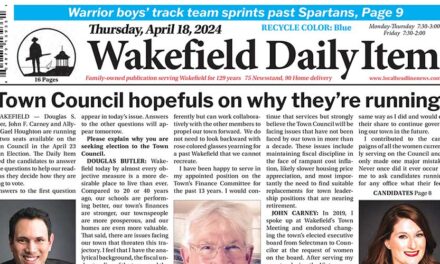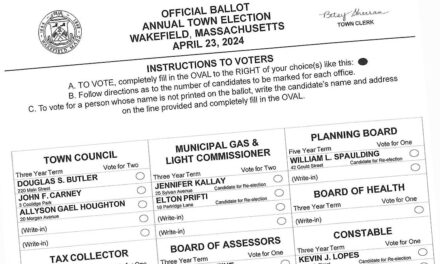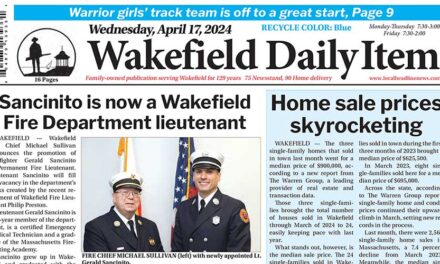Published in the January 31, 2017 edition.
By MARK SARDELLA
WAKEFIELD — Last year, the state of Massachusetts adopted a new law that allows cities and towns to lower their statutory speed limits to 25 mph. Recently, Boston and Somerville took advantage of that new provision to lower statutory speed limits in those cities.
Would such a move make sense for Wakefield? Not according to Wakefield Police Department’s resident traffic expert Lt. Steven Skory, who chairs the town’s Traffic Advisory Committee.
“I am not in favor of lowering the statutory speed limit to 25 mph in Wakefield,” Skory says. “The new law that allows municipalities to lower speed limits to 25 is most beneficial to urban communities like Boston, Cambridge and Somerville which have narrow, congested roadways.”
Understanding how the new law works, Skory says, requires an awareness of the difference between a “regulatory speed limit” and “statutory speed limit.”
A regulatory speed limit is one that is posted on signs. A town can only set or change a regulatory speed limit after a traffic engineering study is completed and the Massachusetts Department of Transportation (MassDOT) and the Registry of Motor Vehicles approve the speed limit.
A statutory speed limit governs the speed of motor vehicles on roadways where no speed limit is posted. The speed limits on roadways that fall into this category are often referred to as “prima facie” speed limits. A “prima facie” speed limit may be thought of as the self-evident maximum safe speed based on the neighborhood and conditions.
The state sets the statutory or “prima facie” speed limits for different categories of roadways from highways down to school zones, but the part of the law that applies to this discussion sets the statutory speed lime at “30 miles per hour in a thickly settled or business district.”
It is important to note that statutory or “prima facie” speed limits cannot be posted, with the exception of a legally established school zone.
It is the statutory – or unposted – speed limits that the new law now allows municipalities to lower to 25 mph along secondary roads in thickly settled or business districts.
“Lowering the speed limit will not change the average speed that vehicles will travel on a particular roadway,” Skory says. “Traffic will continue to travel at the 85th percentile, which is the speed that the majority of motorists feel is safe.”
Skory explains that the “85th percentile” is the national standard for establishing safe speed limits. The 85th percentile is the speed at or below which 85 percent of the motorists travel on a given roadway. It has long been the principal value used for establishing speed control. This method is based on numerous studies which indicate that the majority of motorists are prudent and capable of selecting safe speeds.
That’s one reason why Skory believes that lowering the statutory speed limit to 25 mph in a town like Wakefield would not make sense.
“If 25 mph is more than 7 mph below the 85th percentile, it is not considered reasonable,” he says.
“Currently we only have two areas in town with a speed limit over 30 mph,” Skory points out. “We have a number of special speed zones lower than 30 mph that include the downtown area, Montrose Ave, Nahant Street and Oak Street. School zones have a 20 mph speed limit and are posted with electronic advisory signs.”
When it comes to setting speed limits, Skory points to MassDOT’s advice: “The ideal speed limit maintains safe operating speeds for all road users and is acceptable to the prudent driver and is enforceable by police.”
Skory notes that unreasonable speed zoning has very little permanent effect on the average speed of vehicles (the 85th percentile).
“Speeds must be considered reasonable and proper by the majority of the motoring public,” Skory insists. “Speed limits that are unreasonably low are not enforceable and do not have the long term support of the general public.”
Enforcement is also a major consideration.
“Enforcement of a 25 mph speed limit becomes a huge issue,” Skory says. “In 2016, we issued 1,862 citations for speeding (not including all other traffic violations). The demand for enforcement of a lowered speed limit would overwhelm our resources. Also, there is no benefit to enforcing a speed limit that does not have the long-term support of the public.”
Skory also notes that speeding is not the main cause of traffic accidents.
“There is very little correlation to speeding and traffic accidents,” Skory says. “We had a total of 377 accidents in 2016, which was down from 407 the year before. The majority of accidents are caused by driver inattention (GPS & cell phones), following too close and red light/stop sign violations.”
Skory also points out that speeding in Wakefield’s residential neighborhoods is not as much of an issue as one might think.
“The Police Department has taken many complaints from residents in residential neighborhoods of speeding cars,” Skory says. “We have conducted studies which show the percentage of vehicles speeding is actually very low. It is mostly a case of perceived speed vs. actual speed. When you are stationary on the side of the roadway, it is easily perceived that a vehicle is travelling much faster than its actual speed.”
From a policy perspective, Town Administrator Stephen P. Maio says that he would defer to Skory’s expertise when it comes to how to approach setting speed limits on the town’s roadways.
“He’s the expert,” Maio says. “He’s got great insight into this. At this point, I would certainly back whatever he has to say on it.”




